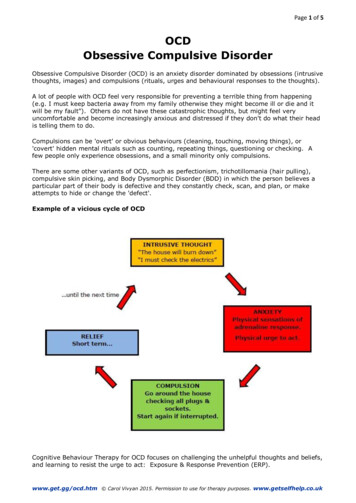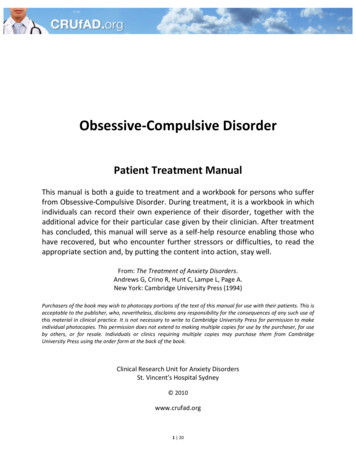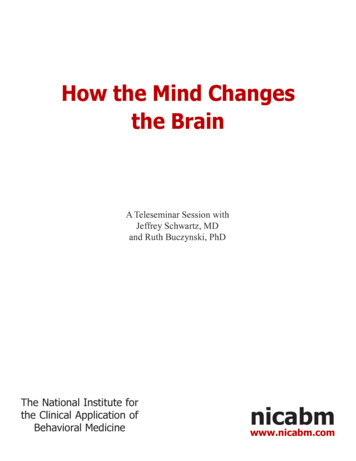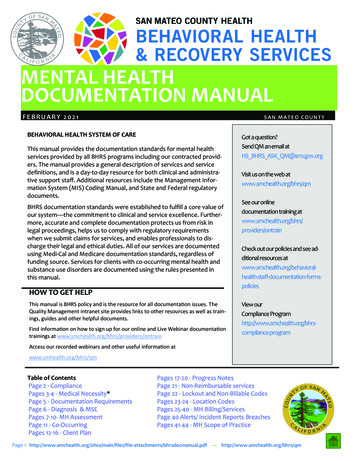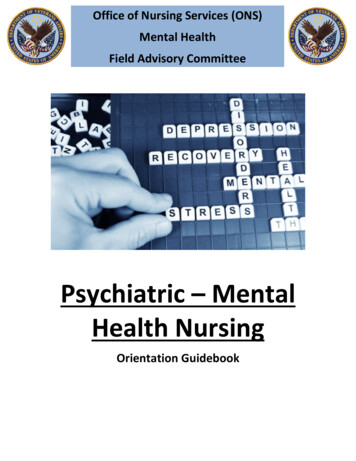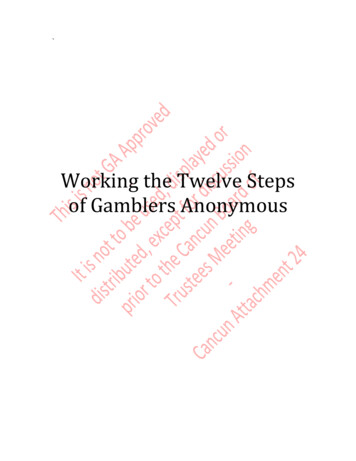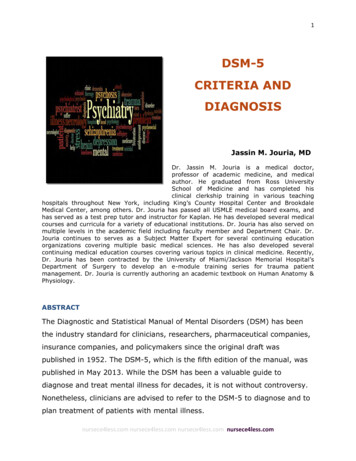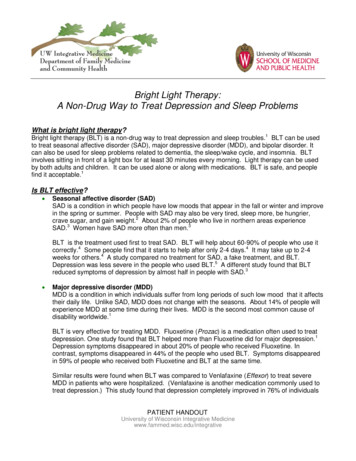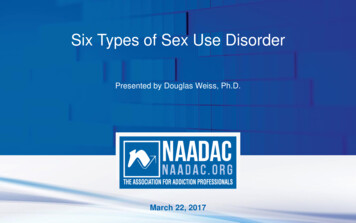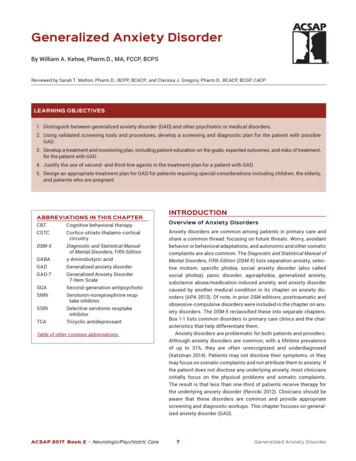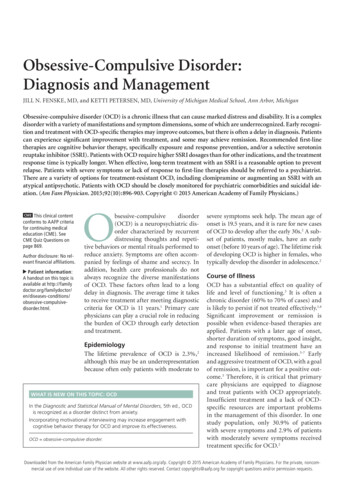
Transcription
Obsessive-Compulsive Disorder:Diagnosis and ManagementJILL N. FENSKE, MD, and KETTI PETERSEN, MD, University of Michigan Medical School, Ann Arbor, MichiganObsessive-compulsive disorder (OCD) is a chronic illness that can cause marked distress and disability. It is a complexdisorder with a variety of manifestations and symptom dimensions, some of which are underrecognized. Early recognition and treatment with OCD-specific therapies may improve outcomes, but there is often a delay in diagnosis. Patientscan experience significant improvement with treatment, and some may achieve remission. Recommended first-linetherapies are cognitive behavior therapy, specifically exposure and response prevention, and/or a selective serotoninreuptake inhibitor (SSRI). Patients with OCD require higher SSRI dosages than for other indications, and the treatmentresponse time is typically longer. When effective, long-term treatment with an SSRI is a reasonable option to preventrelapse. Patients with severe symptoms or lack of response to first-line therapies should be referred to a psychiatrist.There are a variety of options for treatment-resistant OCD, including clomipramine or augmenting an SSRI with anatypical antipsychotic. Patients with OCD should be closely monitored for psychiatric comorbidities and suicidal ideation. (Am Fam Physician. 2015;92(10):896-903. Copyright 2015 American Academy of Family Physicians.)CME This clinical contentconforms to AAFP criteriafor continuing medicaleducation (CME). SeeCME Quiz Questions onpage 869.Author disclosure: No relevant financial affiliations. Patient information:A handout on this topic isavailable at http://family doctor.org/family disorder.html.Obsessive-compulsivedisorder(OCD) is a neuropsychiatric disorder characterized by recurrentdistressing thoughts and repetitive behaviors or mental rituals performed toreduce anxiety. Symptoms are often accompanied by feelings of shame and secrecy. Inaddition, health care professionals do notalways recognize the diverse manifestationsof OCD. These factors often lead to a longdelay in diagnosis. The average time it takesto receive treatment after meeting diagnosticcriteria for OCD is 11 years.1 Primary carephysicians can play a crucial role in reducingthe burden of OCD through early detectionand treatment.EpidemiologyThe lifetime prevalence of OCD is 2.3%,2although this may be an underrepresentationbecause often only patients with moderate toWHAT IS NEW ON THIS TOPIC: OCDIn the Diagnostic and Statistical Manual of Mental Disorders, 5th ed., OCDis recognized as a disorder distinct from anxiety.Incorporating motivational interviewing may increase engagement withcognitive behavior therapy for OCD and improve its effectiveness.OCD obsessive-compulsive disorder.severe symptoms seek help. The mean age ofonset is 19.5 years, and it is rare for new casesof OCD to develop after the early 30s.2 A subset of patients, mostly males, have an earlyonset (before 10 years of age). The lifetime riskof developing OCD is higher in females, whotypically develop the disorder in adolescence.2Course of IllnessOCD has a substantial effect on quality oflife and level of functioning.3 It is often achronic disorder (60% to 70% of cases) andis likely to persist if not treated effectively.1,4Significant improvement or remission ispossible when evidence-based therapies areapplied. Patients with a later age of onset,shorter duration of symptoms, good insight,and response to initial treatment have anincreased likelihood of remission.5-7 Earlyand aggressive treatment of OCD, with a goalof remission, is important for a positive outcome.5 Therefore, it is critical that primarycare physicians are equipped to diagnoseand treat patients with OCD appropriately.Insufficient treatment and a lack of OCDspecific resources are important problemsin the management of this disorder. In onestudy population, only 30.9% of patientswith severe symptoms and 2.9% of patientswith moderately severe symptoms receivedtreatment specific for ume92, Number10 ForNovember2015Downloadedfrom theAmericanFamily Physician website at www.aafp.org/afp.Copyright 2015 American Academyof FamilyPhysicians.the private, 15,noncom mercial use of one individual user of the website. All other rights reserved. Contact copyrights@aafp.org for copyright questions and/or permission requests.
Obsessive-Compulsive DisorderTable 1. Common Symptoms in Patients with Obsessive-Compulsive DisorderObsessionExamplesAssociated compulsive behaviorsAggressiveFear of harming others, recurrent violent imagesMonitoring the news for reports of violent crimes,asking for reassurance about being a good personContaminationFear of being contaminated or contaminating others;fear of being contaminated by germs, infections, orenvironmental factors; fear of being contaminatedby bad or immoral personsWashing or cleaning ritualsPathologic doubt,completenessRecurrent worries about doing things incorrectlyor incompletely, thereby negatively affecting thepatient or othersChecking excessively, performing actions in aparticular orderReligiousThoughts about being immoral and eternal damnationAsking forgiveness, praying, reassurance seekingSelf-controlFear of making inappropriate comments in publicAvoiding being around othersSexualRecurrent thoughts about being a pedophile orsexually deviant; recurrent thoughts about actingsexually inappropriate toward othersAvoiding situations that trigger the thoughts,performing mental rituals to counteract thethoughtsSuperstitionFears of certain “bad” numbers or colorsCounting excessivelySymmetry andexactnessRecurrent thoughts of needing to do things in abalanced or exact fashionOrdering and arrangingAdapted with permission from Grant JE. Clinical practice: obsessive-compulsive disorder. N Engl J Med. 2014;371(7):649.PathogenesisThe pathogenesis of OCD is a complex interplay betweenneurobiology, genetics, and environmental influences.Historically, dysfunction in the serotonin system waspostulated to be the main factor in OCD pathogenesis,given the selective response to serotonergic medication.More recent research has also demonstrated the role ofglutamate, dopamine, and possibly other neurochemicals.8 A proposed model for OCD suggests that geneticvulnerability to environmental stressors may result inmodification of gene expression within neurotransmitter systems. This, in turn, results in changes to brain circuitry and function.8DiagnosisObsessions are recurrent intrusive thoughts or imagesthat cause marked distress. The thoughts are unwantedand inconsistent with the individual’s sense of self (egodystonic), and great effort is made to resist or suppressthem. They can involve contamination; repeated doubts;or taboo thoughts of a sexual, religious, or aggressivenature. Compulsions are repetitive behaviors or mentalrituals performed to counteract the anxiety caused byobsessions. Individuals feel strongly compelled to complete these actions, and the behaviors become automaticover time. They can include handwashing, checking,ordering, praying, counting, and seeking reassurance.Common obsessions and compulsions are includedin Table 1.9November 15, 2015 Volume 92, Number 10In the Diagnostic and Statistical Manual of Mental Disorders, 5th ed., OCD is recognized as a disorder distinctfrom anxiety (Table 2) and is now grouped with severalother disorders with common features, often referred to asobsessive-compulsive–related disorders (Table 3).10 OCDis a complex, heterogeneous disorder, and some presentations are underrecognized. For example, taboo thoughtsmay be attributed to other causes or may not appear to beassociated with overt compulsions. Even when compulsions are not easily observable, patients with OCD usuallyhave mental rituals. Patients are often reluctant to reportsymptoms of OCD for a variety of reasons, includingembarrassment, stigma, and the fear of what the obsessionmight mean or the consequences of revealing it.11Physicians should consider the possibility of OCD inpatients with general complaints of anxiety or depression. Patients may offer clues by alluding to intrusivethoughts or repetitive behaviors. Avoidance of particularlocations or objects, excessive concerns about illness orinjury, and repetitive reassurance-seeking behavior arealso common. It is important to note that obsessivecompulsive personality disorder is a separate diagnostic entity that is not characterized by intrusive thoughtsor repetitive behaviors. Rather, it is a pervasive patternof behaviors emphasizing organization, perfectionism,and a sense of control.10 If true OCD is suspected, theuse of a few simple screening questions can be helpful(Table 4).12 Standardized diagnostic tools are available,but most are not practical for use in primary care. Twowww.aafp.org/afp American Family Physician 897
Obsessive-Compulsive DisorderTable 2. DSM-5 Diagnostic Criteria for Obsessive-Compulsive DisorderA. Presence of obsessions, compulsions, or both:Obsessions are defined by (1) and (2):1. Recurrent and persistent thoughts, urges, or images that are experienced, at some time during the disturbance, asintrusive and unwanted, and that in most individuals cause marked anxiety or distress.2. The individual attempts to ignore or suppress such thoughts, urges, or images, or to neutralize them with some otherthought or action (i.e., by performing a compulsion).Compulsions are defined by (1) and (2):1. Repetitive behaviors (e.g., hand washing, ordering, checking) or mental acts (e.g., praying, counting, repeating words silently)that the individual feels driven to perform in response to an obsession or according to rules that must be applied rigidly.2. The behaviors or mental acts are aimed at preventing or reducing anxiety or distress, or preventing some dreaded eventor situation; however, these behaviors or mental acts are not connected in a realistic way with what they are designed toneutralize or prevent, or are clearly excessive.Note: Young children may not be able to articulate the aims of these behaviors or mental acts.B. The obsessions or compulsions are time-consuming (e.g., take more than 1 hour per day) or cause clinically significant distressor impairment in social, occupational, or other important areas of functioning.C. The obsessive-compulsive symptoms are not attributable to the physiological effects of a substance (e.g., a drug of abuse, amedication) or another medical condition.D. The disturbance is not better explained by the symptoms of another mental disorder (e.g., excessive worries, as in generalizedanxiety disorder; preoccupation with appearance, as in body dysmorphic disorder; difficulty discarding or parting withpossessions, as in hoarding disorder; hair pulling, as in trichotillomania [hair-pulling disorder]; skin picking, as in excoriation[skin-picking] disorder; stereotypies, as in stereotypic movement disorder; ritualized eating behavior, as in eating disorders;preoccupation with substances or gambling, as in substance-related and addictive disorders; preoccupation with having anillness, as in illness anxiety disorder; sexual urges or fantasies, as in paraphilic disorders; impulses, as in disruptive, impulse-control,and conduct disorders; guilty ruminations, as in major depressive disorder; thought insertion or delusional preoccupations, as inschizophrenia spectrum and other psychotic disorders; or repetitive patterns of behavior, as in autism spectrum disorder).Specify if:With good or fair insight: The individual recognizes that obsessive-compulsive disorder beliefs are definitely or probably nottrue or that they may or may not be true.With poor insight: The individual thinks obsessive-compulsive disorder beliefs are probably true.With absent insight/delusional beliefs: The individual is completely convinced that obsessive-compulsive disorder beliefs are true.Specify if:Tic-related: The individual has a current or past history of a tic disorder.Reprinted with permission from the American Psychiatric Association. Diagnostic and Statistical Manual of Mental Disorders. 5th ed. Washington,DC: American Psychiatric Association; 2013:237.commonly used patient self-report inventories are theObsessive-Compulsive Inventory–Revised13 (http://www.cale black.com/psy 5960 files/OCI-R.pdf) and theFlorida Obsessive-Compulsive Inventory 14 (http://www.ocdscales.org/index.php?page scales).OCD is often misdiagnosed as other disorders(Table 5),9,10 although OCD is a common comorbidityfor many of these conditions, and the possibility of morethan one diagnosis should be considered. Psychiatricreferral is indicated if there is diagnostic uncertainty.ComorbiditiesPatients with OCD should be monitored for psychiatric comorbidities and suicide risk.15-17 In their lifetime,90% of patients with OCD meet criteria for at leastone other psychiatric diagnosis.2 The most commoncomorbid diagnoses are anxiety disorders (75.8%),including panic disorder, social phobia, specific phobias, and posttraumatic stress disorder. Other common898 American Family Physiciancomorbidities include mood disorders (63.3%), particularly major depressive disorder (40.7%); impulse controldisorders (55.9%); and substance use disorders (38.6%).2The risk of suicide in persons with OCD is high. In onecommunity survey, 63% of persons with OCD hadexperienced suicidal thoughts, and 26% had attemptedsuicide.18 Comorbidity with depression, posttraumaticstress disorder, substance abuse, or impulse control disorders increases the risk of suicidal behavior.15,16TreatmentOnce OCD is diagnosed, it is important to provide thepatient with information and support. Patients andfamily members should be educated about the chronicnature of OCD and the importance of self-managementskills. Evidence-based medical and behavior therapiescan reduce the severity and frequency of obsessions andcompulsions, and can induce remission in some patients.Because it may take weeks to months for these therapieswww.aafp.org/afpVolume 92, Number 10 November 15, 2015
Obsessive-Compulsive DisorderTable 3. Obsessive-Compulsive–Related DisordersDisorderDiagnostic criteriaClinical featuresPreferred treatmentBody dysmorphicdisorderPreoccupation with perceived defectsor flaws in physical appearancethat leads to repetitive behaviorsor mental acts in response to theapparent concernsPoor insightSeeks care from dermatologistsand cosmetic surgeons to addressperceived defectsSymptom onset during adolescenceWaxing and waning courseCognitive behavior therapy(exposure and responseprevention)Some evidence for SSRIsExcoriation(skin-picking)disorderRecurrent skin picking resulting in skinlesionsRepeated attempts to decrease orstop skin pickingMore common in femalesSymptom onset at the beginningof pubertyHabit reversal therapyLimited studiesevaluating response topharmacotherapyHoardingdisorderPersistent difficulty discarding orparting with possessions because ofstrong urges to save items and/ordistress with discarding itemsAccumulation of possessions toa degree that the space wherepossessions accumulate cannot beused as intended75% of patients with hoardingdisorder have comorbid mood oranxiety disordersThe hoarding causes significantdistress or impairment in functionSymptom onset between 11 and 15years of ageSymptoms or hoarding behaviorsprogressively worsenBehavior therapy targetedtoward removal ofhoarded items andreduction in accumulationof new itemsNo data to gdisorder)Recurrent pulling of hair from any partof the body resulting in hair lossRepeated attempts to decrease orstop hair pullingMore common in femalesSymptom onset at the beginningof pubertyHabit reversal therapyMixed to poor response toSSRIsSSRI selective serotonin reuptake inhibitor.Information from reference 10.to become effective, physicians should inform patientsabout this delay in treatment response and encourageadherence during the early phase of treatment.It is helpful to quantify the severity of symptoms andimpairment before and during treatment. This maybe done using standardized rating scales, or by patientTable 4. Initial Screening Questions forObsessive-Compulsive DisorderDo you wash or clean a lot?Do you check things a lot?Is there any thought that keeps bothering you that youwould like to get rid of but cannot?Do your daily activities take a long time to finish?Are you concerned about putting things in a special order,or are you very upset by mess?Do these problems trouble you?If a person answers “yes” to any of these questions and thesymptom causes distress, a diagnostic interview or patient symptominventory should be administered.NOTE:Information from reference 12.November 15, 2015 Volume 92, Number 10report of the time expended on obsessions or compulsions and the level of distress they cause. The YaleBrown Obsessive-Compulsive Scale—second edition(Y-BOCS-II) is a reliable tool for measuring OCD symptom severity 19 and is available at http://ericwexlermd.com/MB PDFs/OCD/YBOCSII.pdf.Patients should be assessed for suicide risk and presence of comorbidities throughout the course of theirillness. Treatment is indicated when OCD symptomsimpair the patient’s functioning or cause significant distress. Reasonable treatment goals are spending less thanone hour per day on obsessive-compulsive behaviors andachieving minimal interference with daily tasks.17 Psychiatric consultation is recommended for patients withsevere OCD, as measured by the Y-BOCS-II. Figure 1 isan algorithm for the treatment of OCD.17,20-25PSYCHOLOGICAL TREATMENTSCognitive behavior therapy (CBT), specifically exposure and response prevention, is the most effectivepsychotherapy method for treating OCD.17,20,21 Patientsare exposed to anxiety-provoking stimuli, and learn tonot perform compulsive behaviors in response. Ideally,CBT should be administered by a trained health carewww.aafp.org/afp American Family Physician 899
Obsessive-Compulsive DisorderTable 5. Conditions That May Be Misdiagnosed as OCDMisdiagnosisDistinctionsADHDYoung persons with ADHD may procrastinate and have problems with attention and focus; persons with OCDmay appear to have ADHD because they have a need to do things “just right” or in a “complete” fashion andtherefore may not complete tasks; it is important to determine whether mental rituals or obsessive thoughtsinterfere with focus and attentionAnxietydisorderAnxiety is characterized by worry, which often mimics obsessive thinking; anxiety usually focuses on real-lifeproblems (e.g., finances, health, loved ones) without the irrational quality of OCDAutismspectrumdisordersPersons with autism spectrum disorders exhibit persistent deficits in social interactions and may engagein repetitive behaviors perceived as natural and reasonable; OCD can lead to social isolation, but socialcommunication skills are usually preserved; persons with OCD usually view their compulsive repetitive behaviorsas excessive and unreasonableDepressionPersons with depression often ruminate, which may be mistaken for obsession; however, these ruminations are ofa depressed theme (e.g., guilt due to inadequacies or negative self-assessment)PsychoticdisorderPsychosis is often characterized by delusional beliefs; OCD thoughts may also be irrational (e.g., fear ofcontracting human immunodeficiency virus from doorknobs); however, unlike with psychosis, persons with OCDcan usually recognize that their thoughts are irrational but cannot control themTourettesyndromeIn Tourette syndrome, motor or vocal tics are generally involuntary; repetitive behaviors in OCD result from a cognitivesource (e.g., an obsessive desire for symmetry) and the need to perform an action until it is done “just right”ADHD attention-deficit/hyperactivity disorder; OCD obsessive-compulsive disorder.Adapted with permission from Grant JE. Clinical practice: obsessive-compulsive disorder. N Engl J Med. 2014;371(7):650, with additional informationfrom reference 10.professional in an individual or group format, althoughstudies have suggested that self-directed exposure andresponse prevention combined with motivational interviewing may be effective.26,27 Incorporating motivationalinterviewing may increase engagement with therapy andimprove its effectiveness.28 There is no evidence for theuse of psychodynamic psychotherapy or “talk therapy”to treat OCD.PHARMACOTHERAPYOCD has a highly selective response to serotonergicmedications. Clomipramine (Anafranil), a tricyclicantidepressant with a strong serotonergic effect, waspreviously the first-line pharmacologic treatment forOCD. However, because of concerns about its safetyand adverse effects, selective serotonin reuptake inhibitors (SSRIs) are now preferred for initial therapy.17,21 ACochrane review confirmed the effectiveness of SSRIsfor the treatment of OCD (absolute risk reduction 8%to 17%; number needed to treat 6 to 12).29 Fluoxetine(Prozac), fluvoxamine, paroxetine (Paxil), and sertraline(Zoloft) have been approved by the U.S. Food and DrugAdministration (FDA) for the treatment of OCD. Citalopram (Celexa) and escitalopram (Lexapro) are also commonly used, but in 2011, the FDA began recommendingdose limitations for citalopram because of concernsabout QT prolongation.30 There is insufficient evidenceto show that one SSRI is superior,22 and the choice of SSRI900 American Family Physicianshould be individualized, taking into account potentialdrug interactions and tolerability.To achieve optimal response, patients with OCDrequire a higher dosage of an SSRI compared with otherindications.17,31 The dosage should be increased overfour to six weeks until the maximal dosage is achieved(Table 6).30,32 Higher-than-usual maximal dosages aresometimes used, with careful monitoring for adverseeffects such as serotonin syndrome. The trial of therapyshould continue for eight to 12 weeks, with at least fourto six weeks at the maximal tolerable dosage.17 It usually takes at least four to six weeks for patients to noteany significant improvement in symptoms; it may take10 weeks or longer for some.If medical therapy is successful, it should be continuedfor at least one to two years, if not indefinitely.17,22 Relapseprevention with continuous SSRI therapy is a reasonabletreatment goal.33 If the patient chooses to discontinuepharmacotherapy, the dosage should be gradually taperedover several months, and the original dosage resumed ifsymptoms worsen. The response to psychological treatments may last longer than the response to medications.34Periodic “booster” sessions of exposure and responseprevention are recommended to lower the risk of relapsewhen psychological therapy is discontinued.17If an adequate trial of SSRI or psychological therapydoes not result in a satisfactory response, combined treatment is an option.35,36 If the patient prefers to continuewww.aafp.org/afpVolume 92, Number 10 November 15, 2015
Treatment of Obsessive-Compulsive DisorderObsessive-Compulsive DisorderAssess severity of OCDMild to ementComplete initialtreatment courseSSRI with or without CBT*Consider periodic“booster” sessionsof CBT*SatisfactoryimprovementUnsatisfactory improvementSwitch to a new SSRI; add CBT if not already initiatedSatisfactoryimprovementUnsatisfactory improvementInitiate psychiatric referral for treatment resistanceContinue medication for atleast 1 to 2 years (indefinitetreatment is reasonable)Consider periodic “booster”sessions of CBT*Therapy options include:Special PopulationsSwitching to clomipramine (Anafranil)Augmenting the SSRI with an antipsychoticPREGNANCY AND POSTPARTUMCombining an SSRI with clomipramineWomen who are pregnant or in the postpartum period are 1.5 to 2 times more likely toexperience OCD compared with the generalfemale population.42 Women who had OCDbefore pregnancy may have worsening OCDsymptoms and are at higher risk of postpartum depression.42-44 Postpartum OCD maymanifest as intrusive thoughts of harmingthe infant; however, these women are not atincreased risk of injuring their infants.42 CBTis recommended as first-line treatment forOCD during pregnancy and the postpartumperiod. An individual risk-benefit analysisshould be discussed when considering SSRItherapy during pregnancy and lactation.44Going beyond the higher-than-usual maximaldose of the SSRI, with careful monitoring foradverse effects, such as serotonin syndromeUsing an alternative agent: mirtazapine(Remeron) or an SNRI†Trying investigational treatments*—Exposure and response prevention.†—Limited evidence.Figure 1. Algorithm for the treatment of OCD. (CBT cognitive behavior therapy; OCD obsessive-compulsive disorder; SNRI serotoninnorepinephrine reuptake inhibitor; SSRI selective serotonin reuptakeinhibitor.)Information from references 17, and 20 through 25.with medical therapy alone, a trial of a different SSRI iswarranted.17 If there is no response to trials of at leasttwo SSRIs, the patient should be referred to a psychiatrist. Clomipramine is an option in these patients.17November 15, 2015 Because clomipramine can cause anticholinergic adverse effects, and rarely arrhythmiaor seizures, it should be started at a low dosage (25 mg per day) with gradual titration tominimize adverse reactions. Addition of anatypical antipsychotic is effective for somepatients with inadequate response to SSRItherapy.17,25,37 There is conflicting evidenceregarding which atypical antipsychotic agentis most effective, and the usefulness of thesemedications is offset by a higher risk ofadverse effects than SSRI monotherapy.25There are a variety of other options forpatients with treatment-resistant OCD, butthe evidence for most therapies is limited.Some studies support the effectiveness ofserotonin-norepinephrine reuptake inhibitors or mirtazapine (Remeron) for OCD.38-40Other medications under investigationinclude glutamatergic agents, stimulants,pindolol, ondansetron (Zofran), acetylcysteine, and anticonvulsants.23-25 Deep brainstimulation has had promising results forsevere treatment-resistant OCD, but it hasbeen studied in only a small number ofpatients. This treatment is used as a lastresort and has received limited FDA approvalunder the humanitarian device exemption.41Volume 92, Number 10CHILDRENThe prevalence of childhood OCD is 1% to 2% inthe United States, and 50% of these children havecomorbid psychiatric conditions. CBT with exposurewww.aafp.org/afp American Family Physician 901
Obsessive-Compulsive DisorderSORT: KEY RECOMMENDATIONS FOR PRACTICEClinical recommendationPatients with OCD should be monitored for psychiatric comorbidities and suicide risk.Cognitive behavior therapy, specifically exposure and response prevention, is the most effectivepsychotherapy method for treating OCD.SSRIs are recommended as first-line pharmacologic therapy for OCD.A trial of SSRI therapy should continue for 8 to 12 weeks, with at least 4 to 6 weeks at the maximaltolerable dosage.Indefinite SSRI therapy should be considered to prevent OCD relapse. At a minimum, SSRIs should becontinued for 1 to 2 years before attempting to discontinue.Augmenting SSRI therapy with an atypical antipsychotic is effective in some patients with OCD whohave inadequate response to SSRI therapy.EvidenceratingReferencesCA15-1717, 20, 21AC17, 21, 2917C17, 22B17, 25, 37OCD obsessive-compulsive disorder; SSRI selective serotonin reuptake inhibitor.A consistent, good-quality patient-oriented evidence; B inconsistent or limited-quality patient-oriented evidence; C consensus, diseaseoriented evidence, usual practice, expert opinion, or case series. For information about the SORT evidence rating system, go to http://www.aafp.org/afpsort.and response prevention is the preferred initial treatment for mild to moderate cases.45 Family involvementis important for successful outcomes.45,46 Treatment withSSRIs, in addition to CBT, is indicated for patients withsevere symptoms or comorbid psychiatric conditionslimiting CBT participation. CBT with or without medication is superior to medication alone for treatment ofchildhood OCD.47Abrupt onset of obsessive-compulsive symptoms inchildren may raise concern for pediatric autoimmuneneuropsychiatric disorders associated with streptococcal infection (PANDAS). The term PANDAS is fallingout of favor because of controversy regarding the etiologic role of group A streptococcal infection. A proposed new label for this diagnosis is childhood acuteneuropsychiatric symptoms (CANS).48 CANS has manyproposed etiologic factors, including infectious, toxic,and metabolic causes. There are currently no standardguidelines for the management of CANS, but a comprehensive evaluation is recommended, and empiric antibiotics are not indicated.48Table 6. SSRIs Commonly Used to Treat ObsessiveCompulsive DisorderDosage (mg per day)SSRIStartingTargetMaximalCost*Citalopram (Celexa)Escitalopram (Lexapro)Fluoxetine (Prozac)‡Fluvoxamine‡2010205040†2040 to 6020040†4080300Paroxetine (Paxil)‡Sertraline (Zoloft)‡205040 to 6020060200 4 ( 200) 13 ( 240) 4 ( 305) 17 (notavailable) 4 ( 160) 10 ( 215)FDA U.S. Food and Drug Administration; SSRI selective serotonin reuptakeinhibitor.*—Estimated retail price of one month’s supply (starting dosage) based on information obtained at http://www.goodrx.com (accessed August 26, 2015). Generic pricelisted first, brand price listed in parentheses.†—The FDA recommends against citalopram dosages 40 mg per day (or 20 mgper day in patients older than 60 years or with hepatic impairment) because of concern for QT prolongation. If a higher dosage is necessary, the patient should be monitored using electrocardiography and electrolyte measurements.30‡—FDA approved for the treatment of obsessive-compulsive disorder.Information from references 30 and 32.902 American Family
Nov 15, 2015 · CME Quiz Questions on page 869. Auth
